What Is a Competitive Audit?
A competitive audit is a structured way to identify and research your competitors.
It helps you analyze their performance, identify threats they pose to your brand, and uncover opportunities to gain a competitive advantage.
A well-conducted audit informs your marketing strategy and gives you a roadmap for strategic next steps. It also establishes benchmarks you can use to measure how the business is performing.
In this article, we’ll share how to conduct a competitive audit, the tools to do it right, and actionable insights to drive business growth.
Why Do You Need Competitive Audits?
Marketers must keep track of their rivals’ actions to understand industry trends, evaluate strategies, and maintain a competitive edge.
But regularly monitoring the competitive landscape can be tricky, especially in rapidly changing markets.
That’s why you need competitive audits. They provide a systematic and efficient approach that helps you monitor your competitors’ actions.
Most businesses perform competitive audits to impact core business indicators like organic traffic and lead volume.
Here are some of the tangible benefits you’ll get from this approach:
Identify Key Differentiators
Analyzing your competitors’ offers helps you pinpoint their unique selling points (USPs) and distinguish their products or services.
That enables you to better communicate your value proposition to customers and increase your market share.
For example, MailerLite has made customer service a top priority and has even won awards for its support team.
The company offers 24/7 live chat support and a helpful knowledge base to help customers find answers quickly.
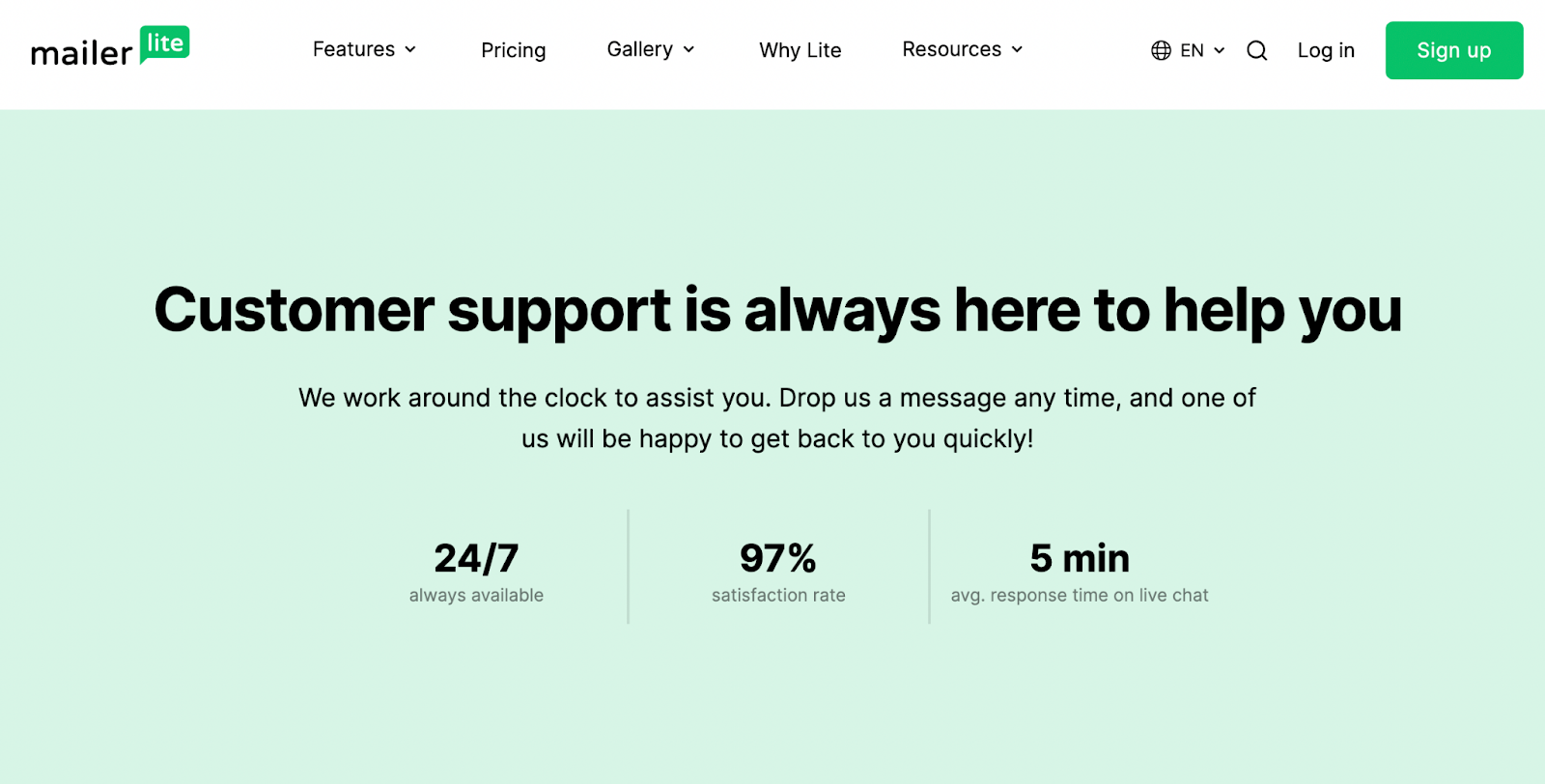
Mailchimp, its most significant competitor, received criticism for restricting access to customer service through a pay-as-you-go plan.
MailerLite attracted customers by differentiating its accessible, high-quality customer service and prioritizing responsive and helpful support.
Improve Your Marketing Strategy
Competitive audits enable you to uncover potential opportunities to better communicate the value behind your product or service.
That’s especially important while you revise your marketing strategy. Audits can ensure your marketing activities:
- Relate to your customer’s challenges, needs, and expectations
- Use tactics that will differentiate you from your competitors
- Line up with your goals and objectives
For example, say you own a company providing help desk software.
Your sales team recently reported that customers don’t see a clear distinction between your solution and one of your competitors.
To address this situation, you audit your competitor’s offer and compare it with yours. You find out both address customer problems identically.
But you also find out your solution has a much more user-friendly interface and offers better solutions for small customer support teams.
Those insights help you improve your product positioning and prepare battle cards for sales that address customer concerns proactively.
For instance, take Help Scout. It highlights its unique differentiators (compared to Zendesk) on its website:
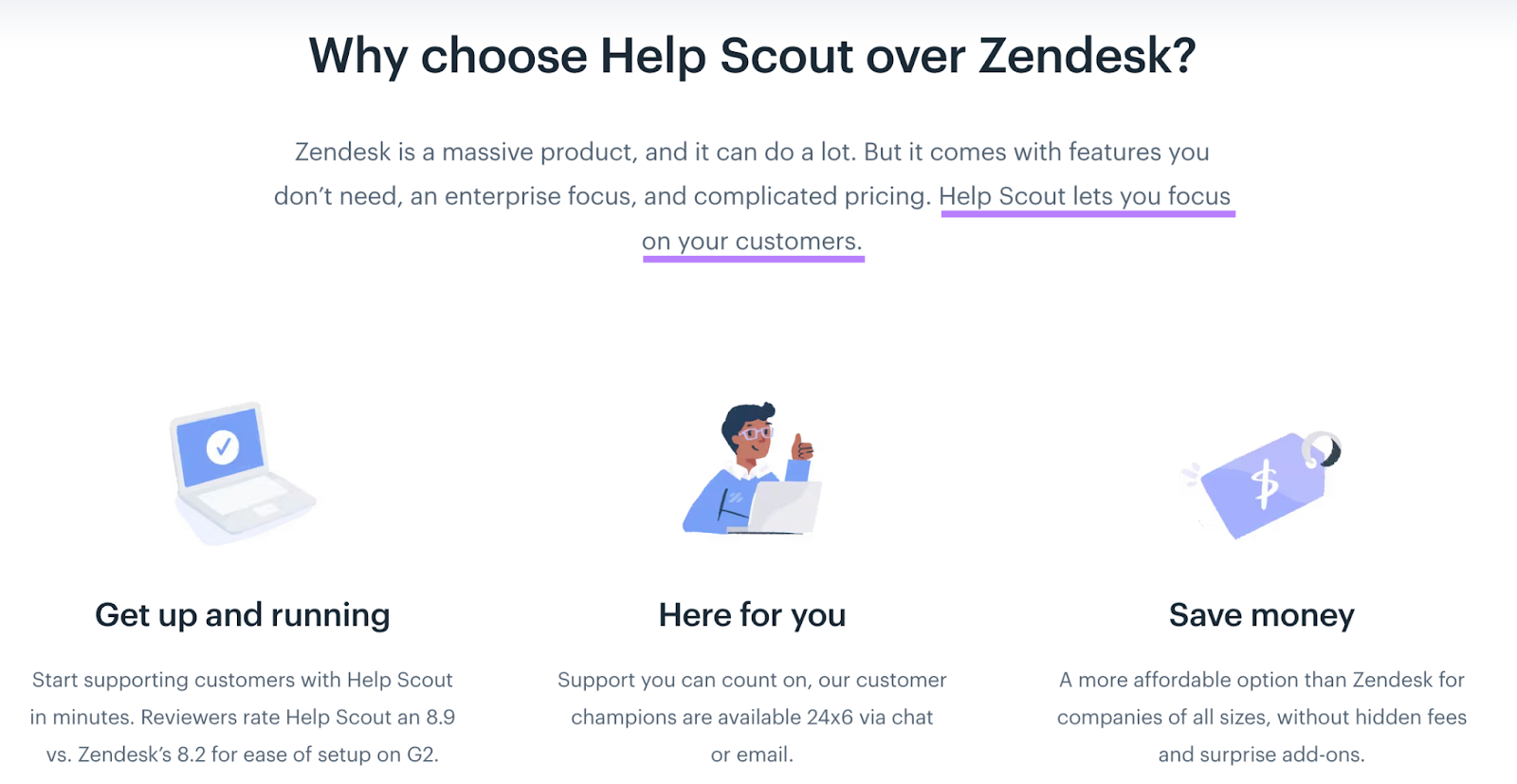
Above the fold, the company frames its solution as a lighter, simpler, and more affordable option for its ideal customer profile—small and medium-sized businesses.
That helps potential customers grasp what the company does and why they should choose it over the competition.
Enhancing SEO and Digital Marketing
Analyzing competitors’ online presence allows your marketing team to identify successful keywords, backlink strategies, and other digital marketing efforts.
You can then leverage this information to drive more organic traffic to your website and increase brand visibility.
Say you’re a marketing manager for Adidas. While preparing your competitive audit, you want to see what potential high-quality backlinks you can acquire to improve your company’s rankings.
Using Semrush’s Backlink Gap tool, you can quickly compare your number of referring domains to your competitors. That helps you understand how much work you need to put into increasing brand visibility.
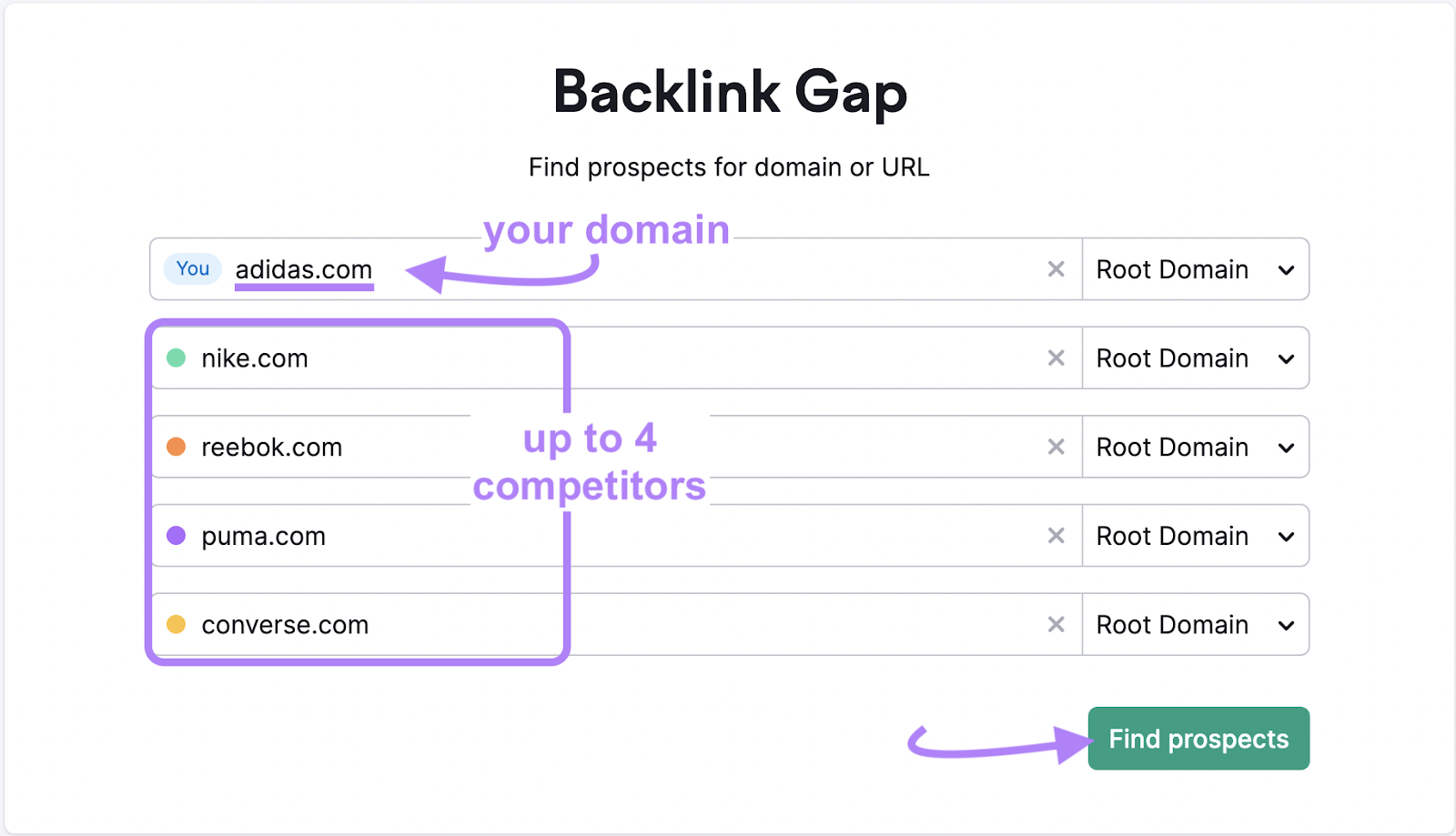
Semrush also curates a list of prospective domains you may want to contact to gain new backlinks.
Using the “Matches” column, you can identify if a domain is popular in your niche and if it’s a good outreach target.
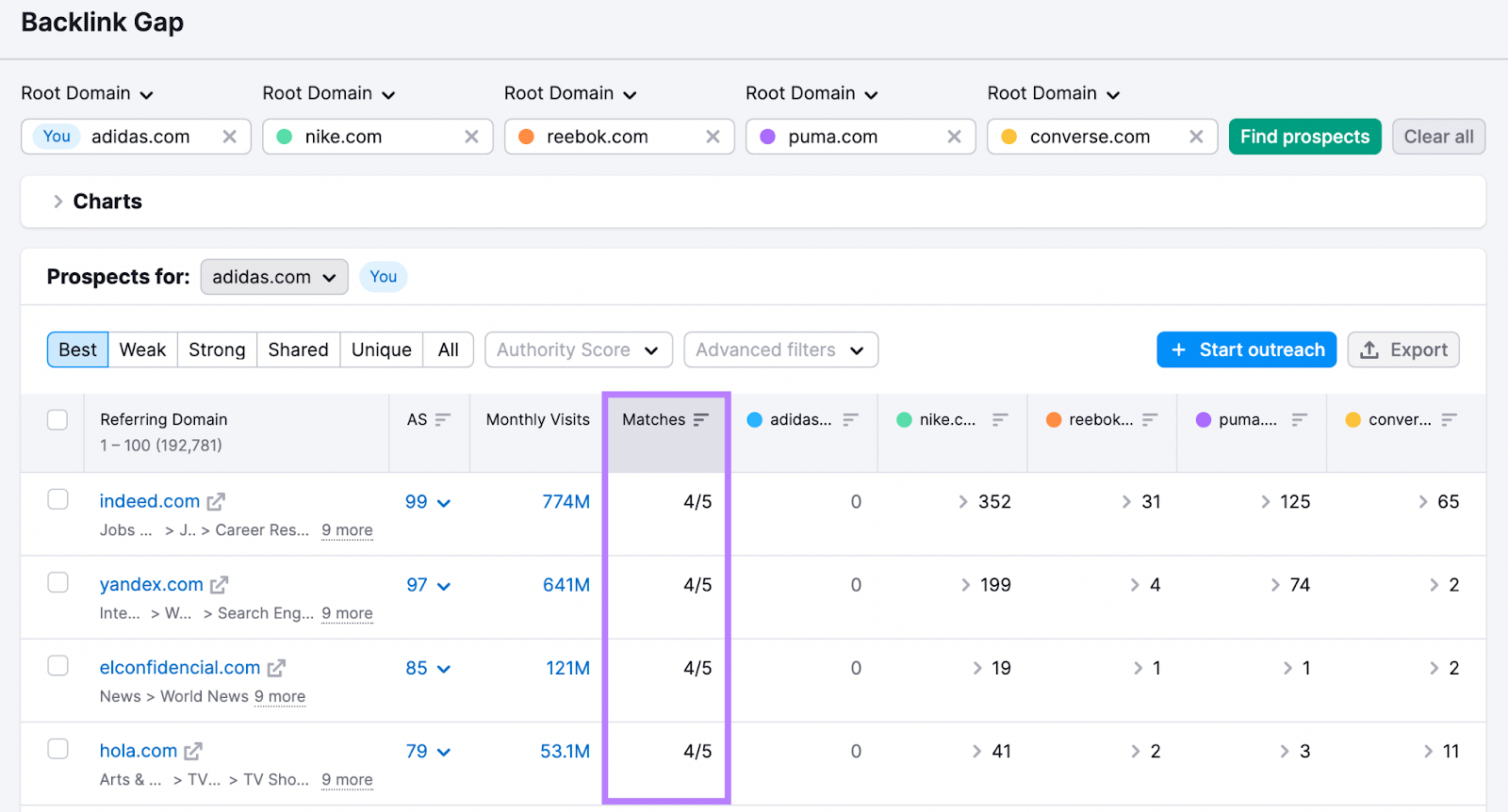
Benchmark Performance
A competitive audit also helps you evaluate your marketing performance against competitors.
This provides insights into areas where your business is excelling or underperforming, allowing for targeted marketing strategies and tactical improvements.
For instance, imagine you’re a small coffee shop owner.
You might start your content audit by researching other local coffee shops to see how they’re marketing themselves.
Perhaps you notice that one of your competitors offers a well-received loyalty program.
That could indicate an area where your business is underperforming, so you may want to implement a similar program to attract and retain customers.
What Are the Different Types of Audits?
There’s more than one type of competitive audit. Let’s look at a few specific competitor audit examples.
Competitor Traffic Audit
You can run a traffic audit to identify how competitors get visitors and how much traffic they generate.
This data allows you to make important marketing decisions and set key benchmarks like:
- Social media or SEO channels to prioritize so you can capture market share
- The most searched product categories so you can update or release new features (if they align with your goals and audience needs)
- Effective partnerships and media placements to get your offer in front of audiences well-positioned to take an interest
A great way to do this is with Semrush’s Traffic Analytics. This tool helps you define current industry leaders and discover growth opportunities for your brand.
For instance, if you aim to set up an online store selling sports shoes, a traffic audit can help you see which of your competitor’s products attract the most attention.
If we run a traffic analysis on Adidas, we can see a clear overview of which pages drive traffic, which pages don’t, and how trends change over time:

These metrics help you uncover:
- The company’s most popular products
- Channels driving the most traffic to each page
- Landing pages Adidas is promoting actively
- Pages that are gaining or losing traction
We highlighted one of the most popular pages for Adidas (besides the main page).
Note how the circled results page generates more than 600,000 unique page visitors. If we visit it, we reach their hardware collection:
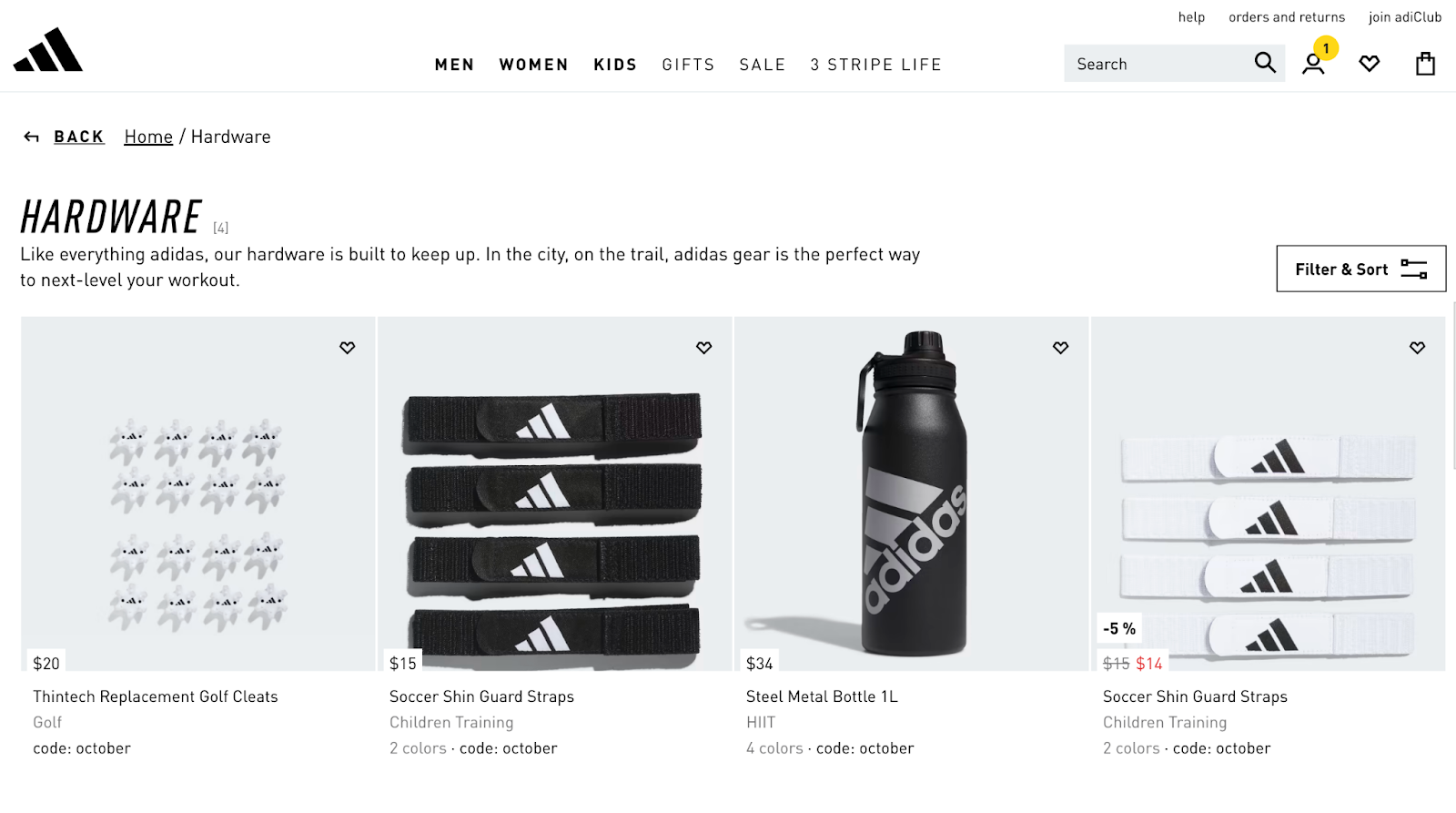
Adidas customers are interested in high-quality sports accessories that will make their training easier.
Based on that information, you may want to double down on sports hardware and accessories to complement your main offering (sports shoes).
That way, you’re catering to industry-wide customer demand and capturing greater market share.
Content Audit
Content audits help you understand how your competitors use content to engage with their audiences and drive interest in their products or services.
For example, imagine you own a small online store selling mattresses and acquire most of your customers through organic traffic from the blog.
Organic traffic dipped recently—and you’re unsure why.
By performing a content audit, you realize you need to optimize for organic search by adding new keywords, increasing the word count, and improving readability.
Users will see your optimized content as authoritative and accessible. As a result, you could rank higher on search engine results pages (SERPs) while increasing market share and name recognition.
Pricing Audit
A pricing audit is a great method to embrace value-based pricing from customer insights and data. Competitor pricing is important, but customer data must also play a role in your decision-making process.
Analyzing market or industry prices helps you understand your competitors’ strategies and identify areas for improvement.
For example, Wistia, a video software-as-a-service (SaaS) company, discovered its customers use videos as a value metric. The more videos Wistia lets users upload, the more they’re willing to pay.
Based on these user experience (UX) insights, it changed its pricing strategy.
Want to upload more? Pick a higher-priced plan:
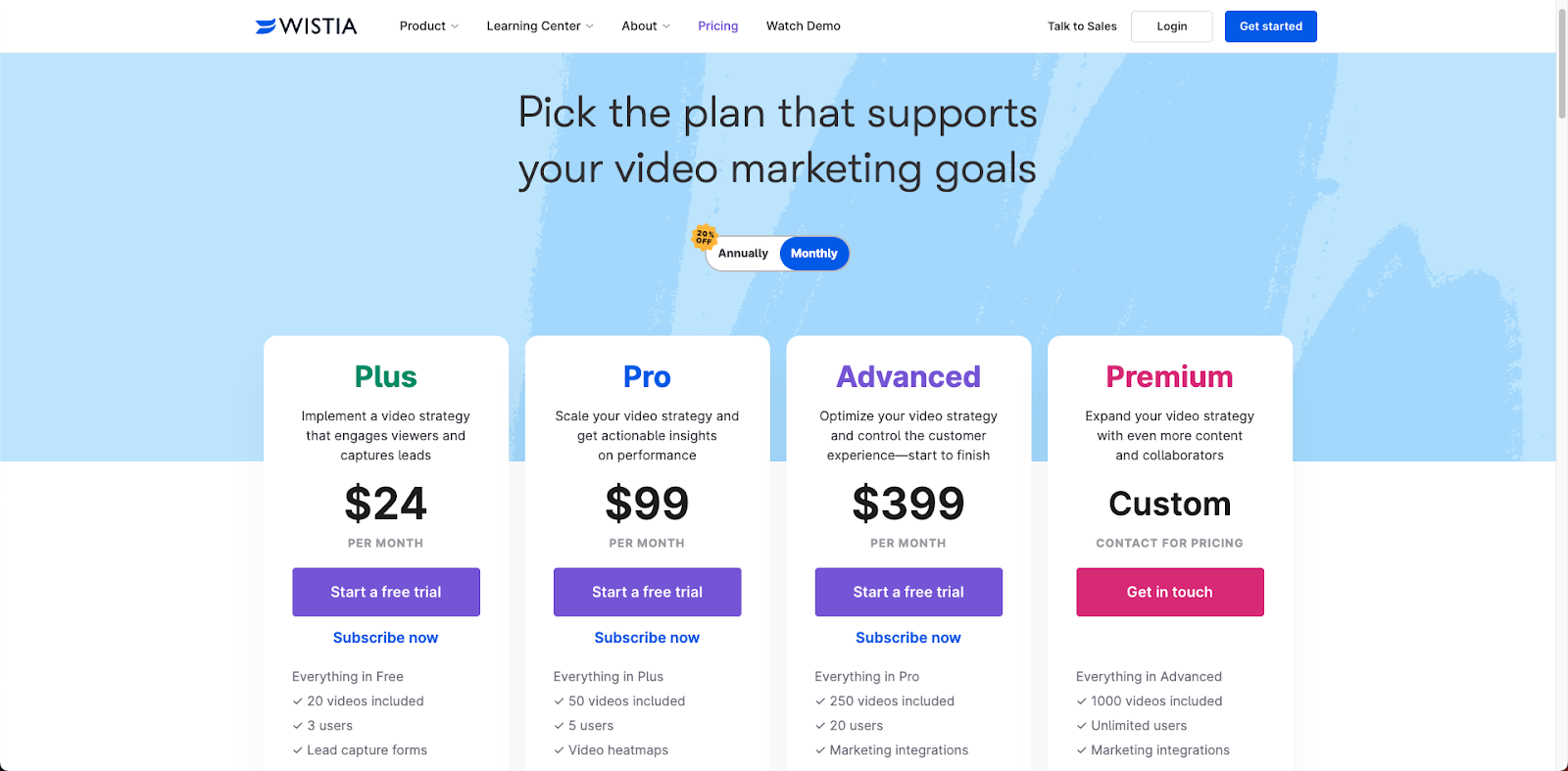
Wistia generated 2x more sales thanks to this new strategy.
How to Conduct a Competitive Audit in 7 Easy Steps
With the right process in place, competitive audits allow you to gather valuable data quickly and start taking action to make your business stand out.
Here are seven steps to conduct an effective competitive audit:
1. Define the Audit Goals
Outline clearly why you’re running the competitive audit, what you’re trying to accomplish, and how you’ll measure the outcomes.
For example, a goal could be doubling the volume of organic monthly SEO sessions.
Defined goals help you stay focused on relevant competitors and avoid getting overwhelmed by excess data.
For instance, if you plan significant changes in your company, the scope of your competitive audit will be much more extensive than if you were simply reviewing the competitive landscape to gauge the latest trends.
For marketing teams, a competitive audit could involve analyzing your competitors’:
- Content marketing quality to determine gaps
- Social media presence to see on which platforms they’re strongest and weakest
- SEO efforts to gather insights and improve strategies
But you may also analyze areas relevant to other teams in your company, like pricing strategies and product development.
Get clear on what you’re focusing on, what you hope to achieve, and how you’ll measure it. That will save you time and keep you on track.
2. Identify Your Competitors
List your primary and secondary competitors to focus your research efforts in the right places.
Semrush’s Market Explorer tool gets you a list of top players in your industry, selected by their volume of total, direct, referral, search, social, and paid traffic.
With a full list of websites competing for online visibility in your niche, you can detect primary competitors while identifying indirect and aspiring rivals.
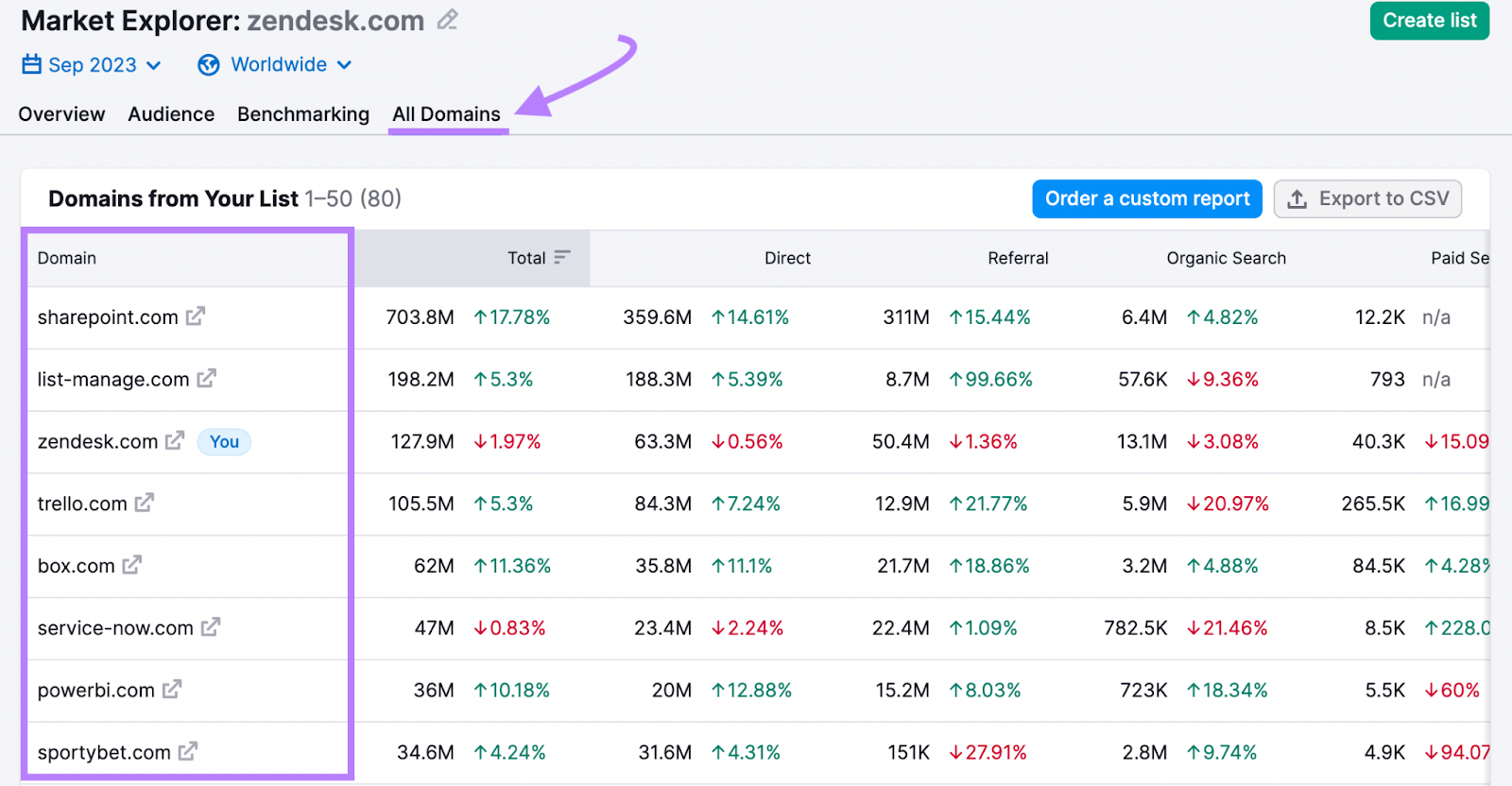
Primary competitors are businesses offering similar products or services targeting the same audience.
Secondary competitors might target a different audience or offer slightly different solutions.
For example, if you sell smartphones, primary competitors could be other smartphone manufacturers. Secondary competitors could be companies selling tablets or laptops.
If you want to understand your market, defining both kinds of competitors is critical.
3. Gather Data on Competitors
You now have a list of primary and secondary competitors in hand. Ask yourself for each:
- What products/services are they offering?
- How much do they charge for them?
- What audience are they targeting?
- How do they position their brand?
Answering those questions will allow you to maintain a competitive edge and make informed strategic decisions.
You can start by examining your competitors’ mentions, audience sentiments, and social media channels.
Semrush’s Social Tracker allows you to uncover details and gather information about their social media presence.
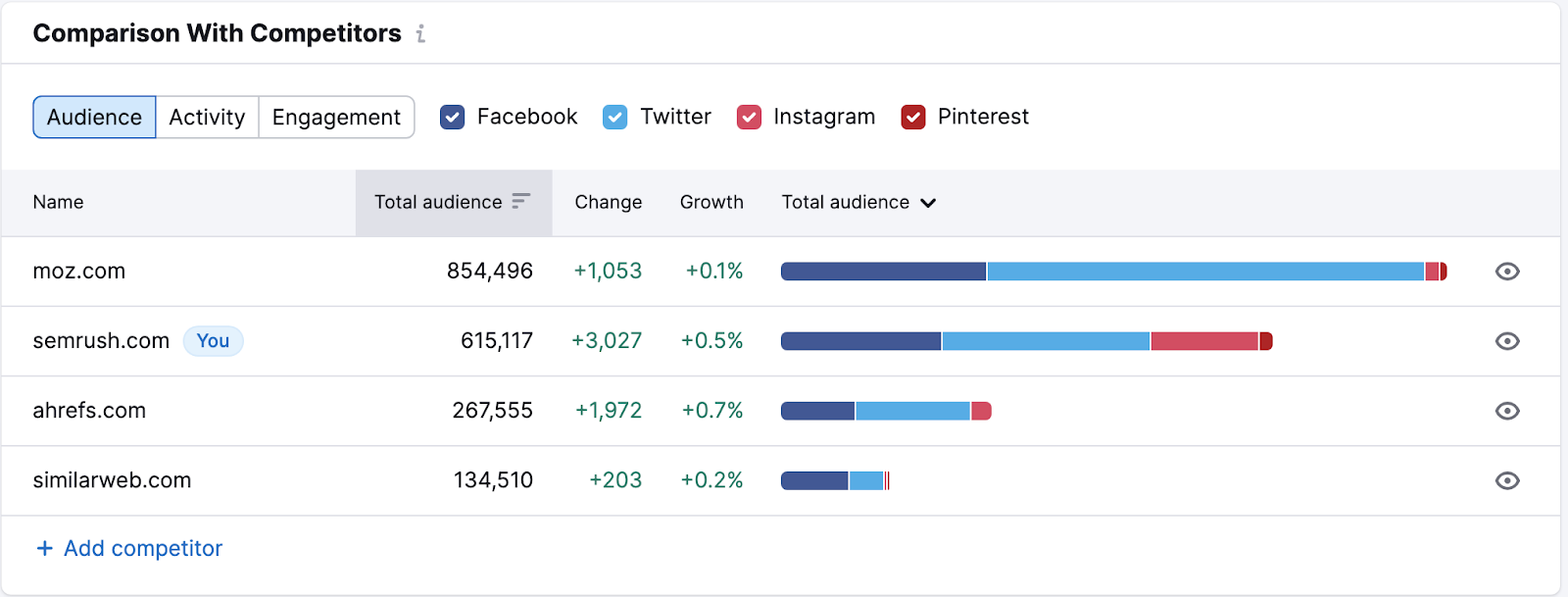
It gives you a snapshot of your social channels versus your competitors, allowing you to see audience growth and engagement levels. The tool can also help you identify the top-performing content in your niche.

You can use this data to determine the types of posts and campaigns that resonate most with your audience. Helping you stay ahead of your competition’s social performance and potentially attract some of their customers.
The Domain Overview tool can also help. Start by putting a domain in the search bar. For this example, we’ll use amazon.com.

You’ll get a high-level overview of a domain’s strengths.
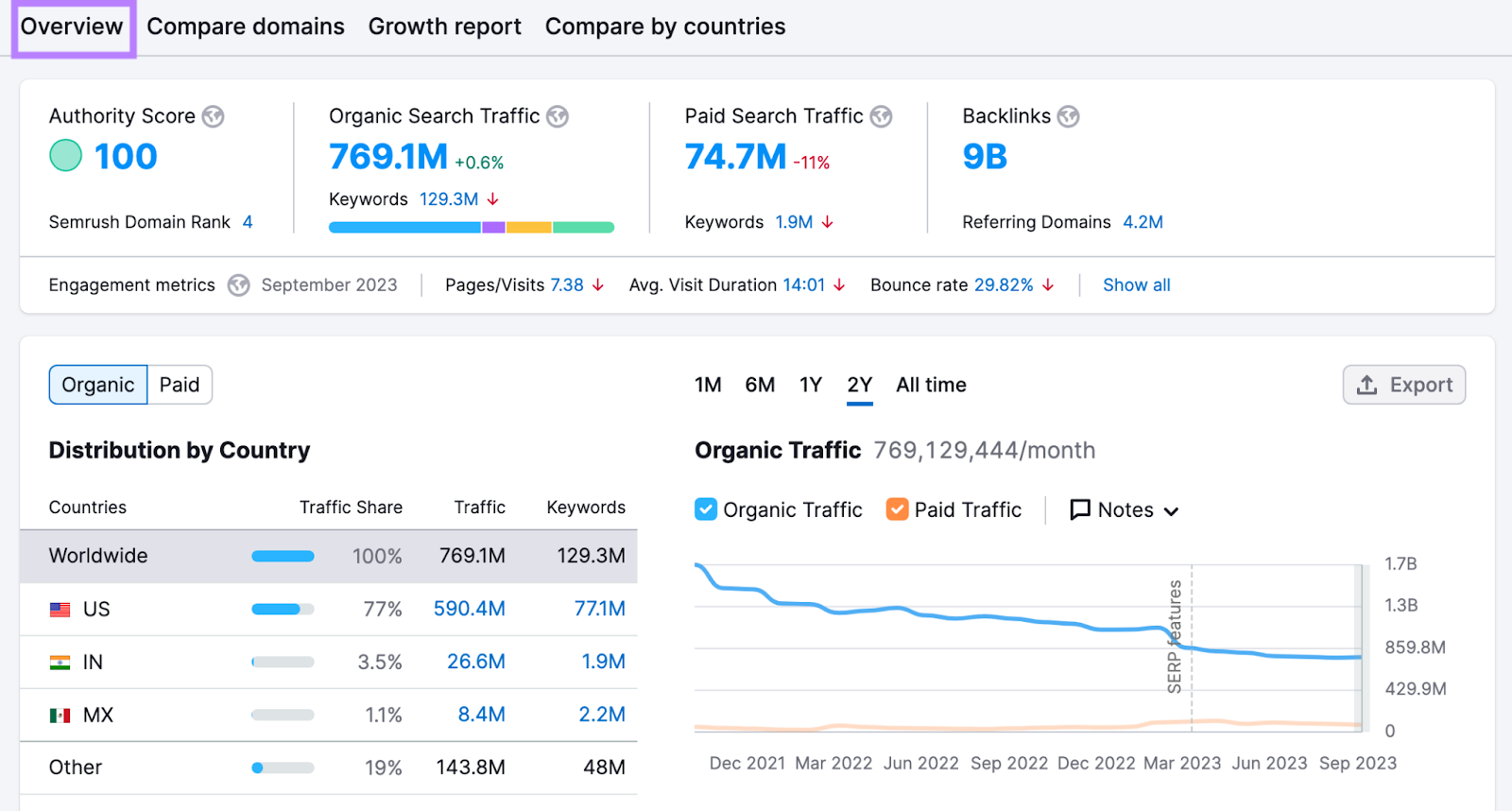
Scroll down and you’ll find a list of organic competitors, along with their positioning.
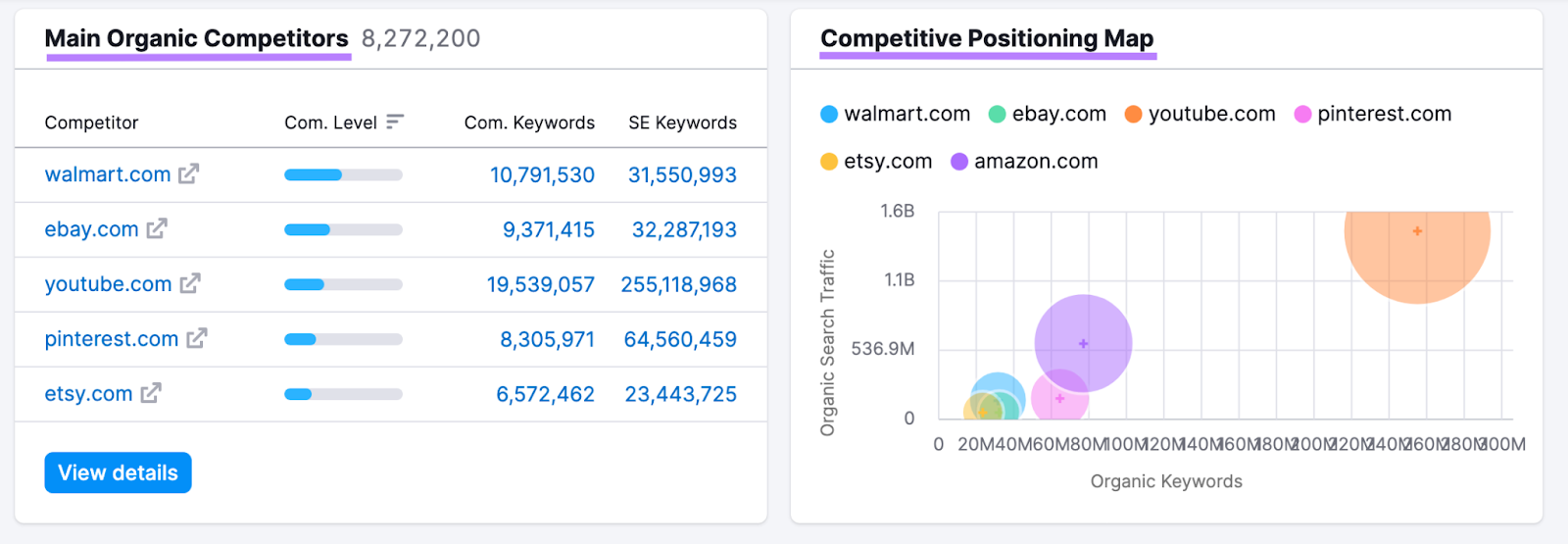
Add those competitor URLs in the “Compare domains” view to see metrics like traffic share, non-branded vs. branded keywords, and paid vs. organic keywords.

Use information from both Semrush tools to get a complete view of the competitive landscape.
4. Perform a SWOT Analysis and Create a Matrix
Organize your collected data in a structured format, such as a SWOT analysis. It consists of the following elements:
- Strengths: Advantages you have over your competitors, like innovative products, strong brand reputation, and efficient processes
- Weaknesses: Disadvantages your competitors could exploit, like poor brand reputation, limited resources, and low employee morale
- Opportunities: External factors that could potentially benefit an organization, like emerging markets, new technologies, and changes in consumer behavior
- Threats: External factors that could potentially harm an organization, like economic downturns, increased competition, and technological upheaval
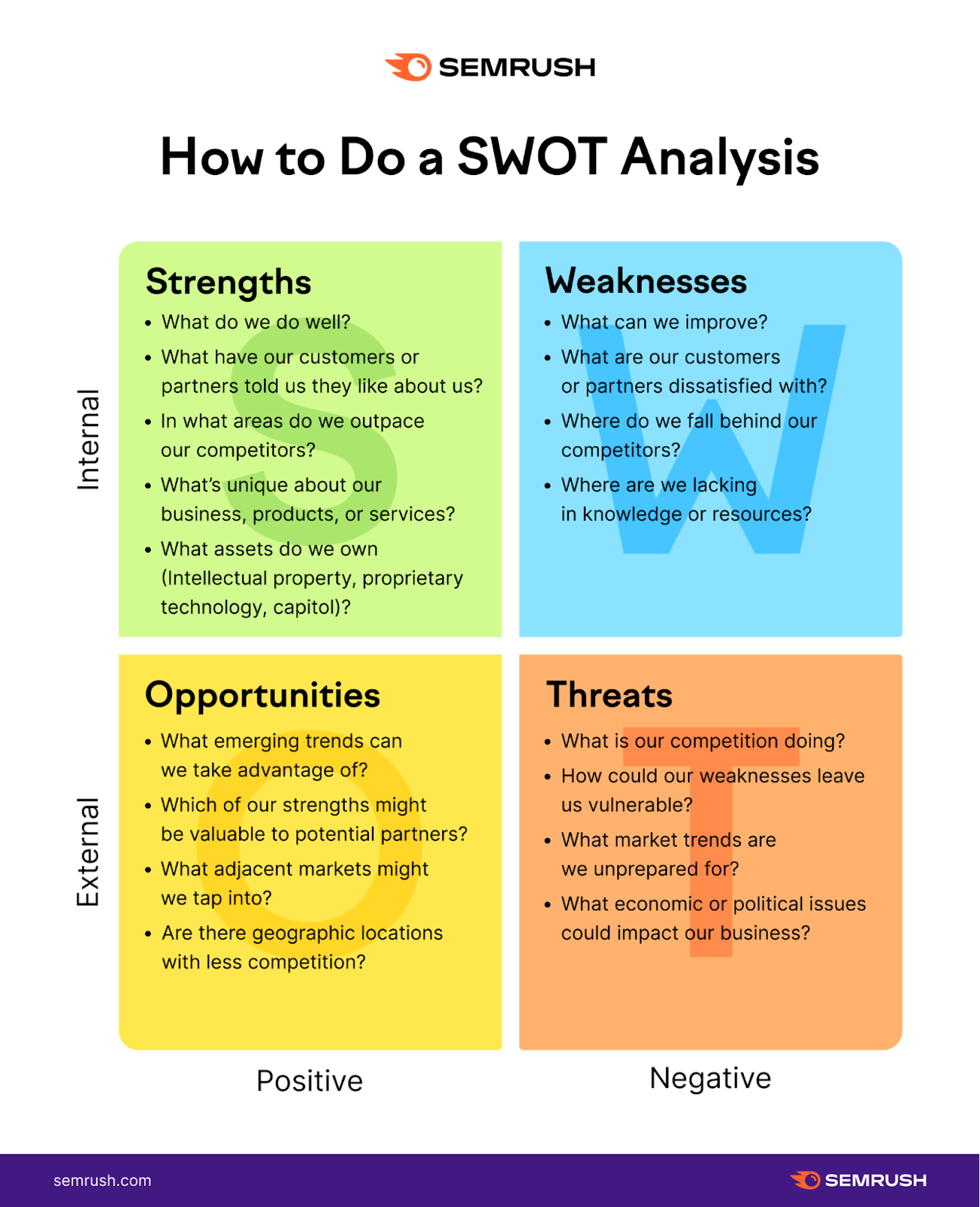
A structured format like a matrix helps break down complex data into clear, manageable categories and improves your focus on the most important points.
You can use Semrush Growth Quadrant (part of Market Explorer) to map out the competitive landscape.
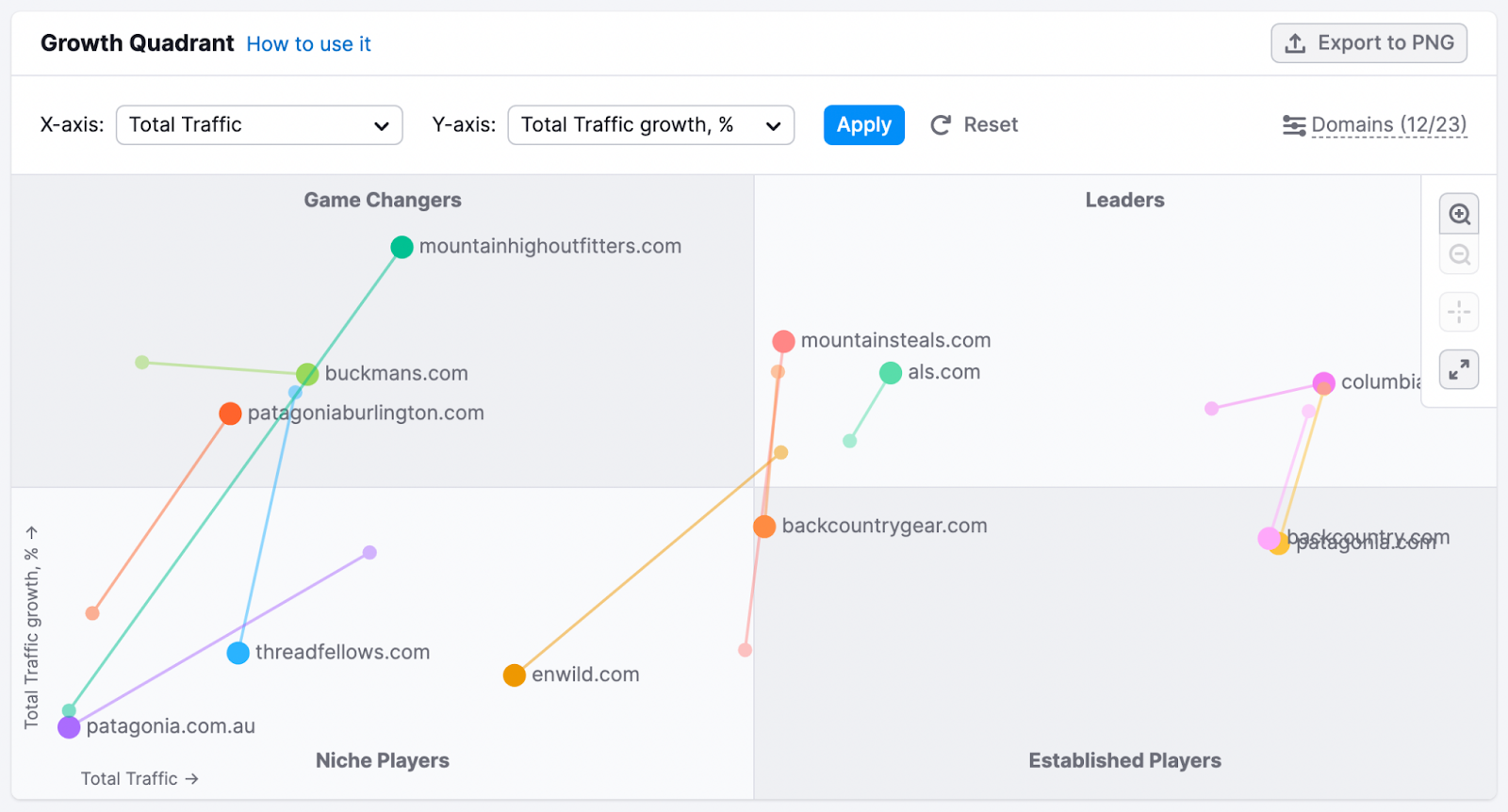
It categorizes your competitors into four sections:
- Game Changers: Companies with a smaller audience size that are growing quickly
- Leaders: Companies with a large audience that also grow fast
- Niche Players: New or small companies with smaller audience size and low growth rate
- Established Players: Companies with a large, constituted audience
Using Growth Quadrant, you can assess growth rates and gain in-market audience insights.
By comparing your performance to the competition, you can understand where you excel and where you need improvement.
5. Identify Opportunities to Get Ahead
Competitor audits can help identify underserved customer segments. That presents potential growth opportunities.
For example, your competitive audit might reveal that your competitors aren’t using specific keywords in their website content.
This lack of competition gives you a significant advantage in the market.
The Keyword Gap tool offers a comprehensive analysis of a competitor’s search environment for a given term.
You can identify gaps in the landscape and use them to your advantage. That is a crucial aspect of putting your audit into practice.
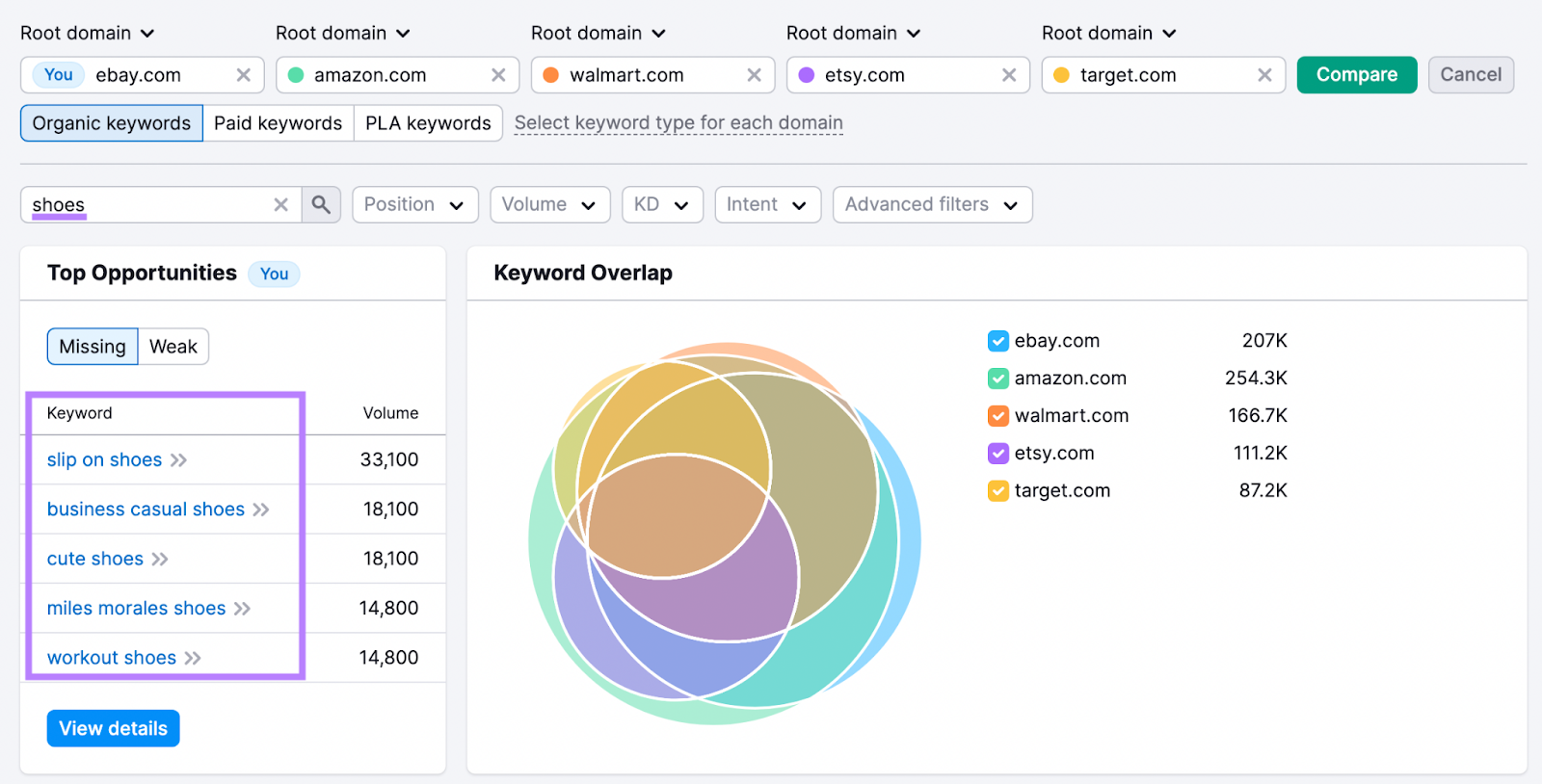
You can better communicate your value proposition and attract new customers by emphasizing these key differentiators in your marketing and sales messaging. Show how your product improves upon the competition, attracting business from interested consumers.
Likewise, focusing on untapped opportunities can help your business expand into new markets and increase its market share.
6. Identify Critical Action Items
Based on the insights gained from the competitive audit, identify key action items that will help you achieve your goals. These actions should be specific, measurable, and aligned with your business objectives.
For example, suppose one of your goals was to improve sales battle cards.
In that case, an action item could be to create a comprehensive competitor comparison chart highlighting your product’s unique features and benefits.
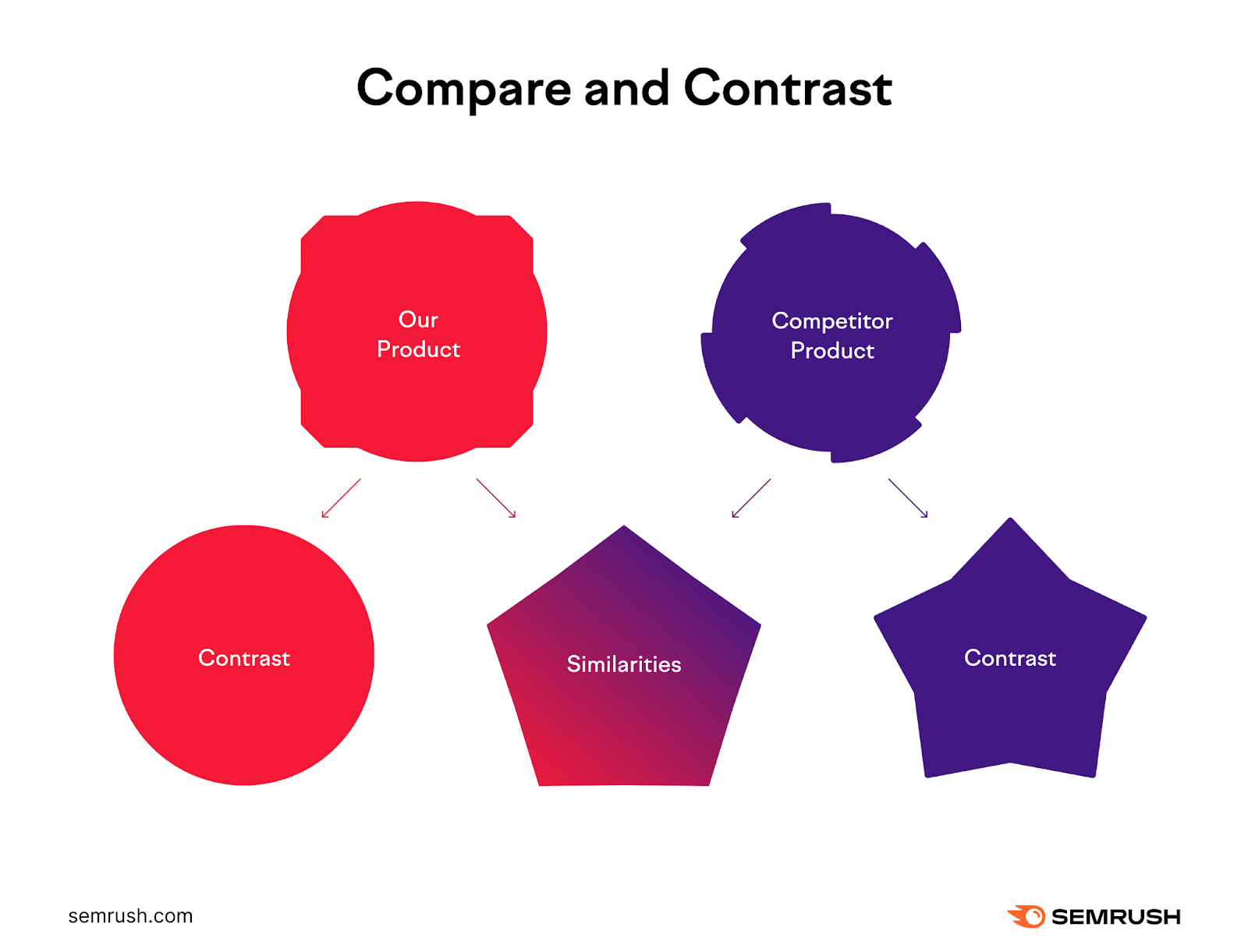
That could influence the sales team and provide them with a valuable tool for overcoming objections and closing deals.
7. Monitor and Update Regularly
Competitive landscapes evolve constantly. Regularly monitoring and updating your competitive audit ensures that your business stays informed and agile.
Determine what cadence works best for you. That might be every three months, every six months, or annually.
No matter which frequency you choose, be sure to identify changes in competitor strategies, market conditions, and customer needs. That will enable you to adapt and maintain your competitive advantage.
Use Semrush’s My Reports tool to automate the reporting process and track every key performance indicator (KPI) without spending hours digging through data.
You can set a schedule for updating the essential elements of your competitive audit, like organic search or advertising performance.
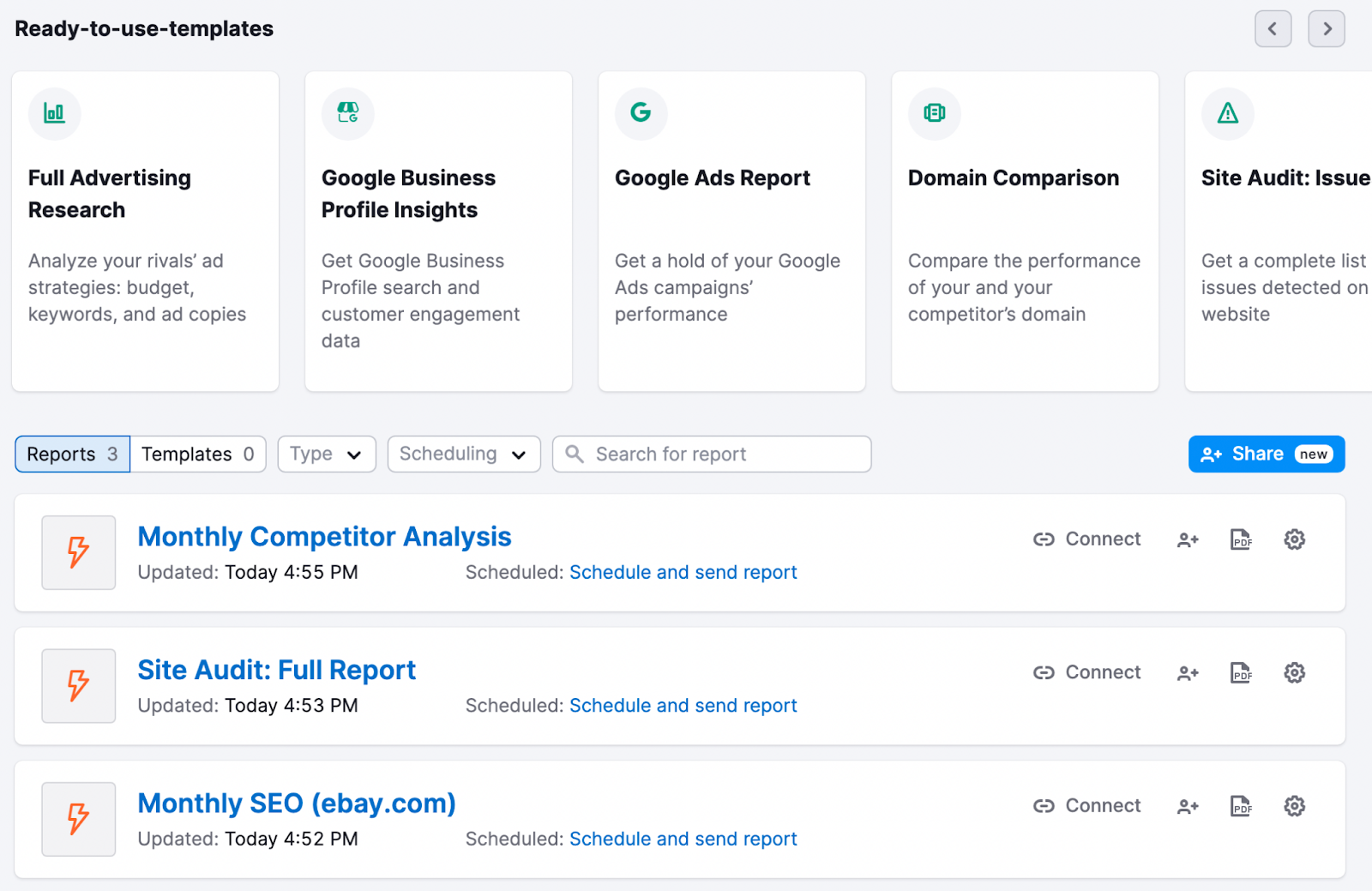
Integrating various data points of your business (Google Search Console, Google Analytics, Google Business Profile, and others) allows you to connect the dots quickly. And turn raw data into actionable insights about your current performance.
By following these steps and conducting a thorough competitive audit, your marketing and sales teams will be better equipped to identify and capitalize on opportunities. Leading to increased success in a competitive marketplace.
With the right tools, you can gather valuable insights and make data-driven decisions to stay ahead of the competition.
Here are the top five tools you can use to conduct a competitive audit:
Semrush
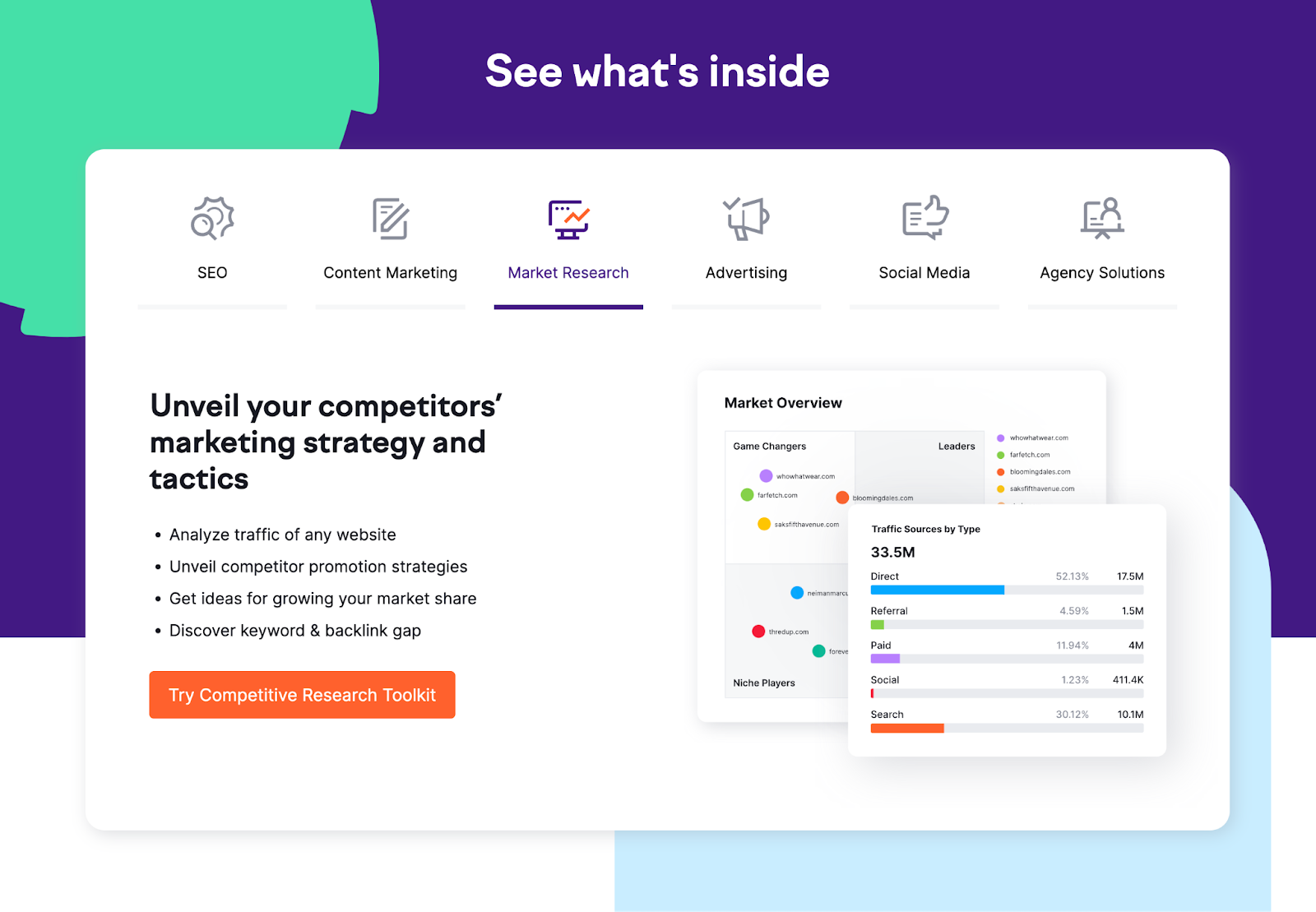
Semrush is a powerful, all-in-one visibility management platform that gives you insights into your competitors’ entire marketing strategy.
Semrush provides several tools for comprehensive competitor analysis to boost your audits with insightful data:
- Traffic Analytics: Compare your website traffic with your competitors
- Organic Research: Find opportunities to outrank your competitors and acquire more organic website traffic
- Advertising Research: Discover ways to beat the competition in paid search
- Social Tracker: Analyze your competitors’ social media and discover new ways to increase engagement
That ensures you’re aware of what’s happening in your market and can make informed decisions about your marketing strategy.
Locate your competitors, find the low-hanging-fruit opportunities to take advantage of, and reverse engineer your way to success.
Crayon
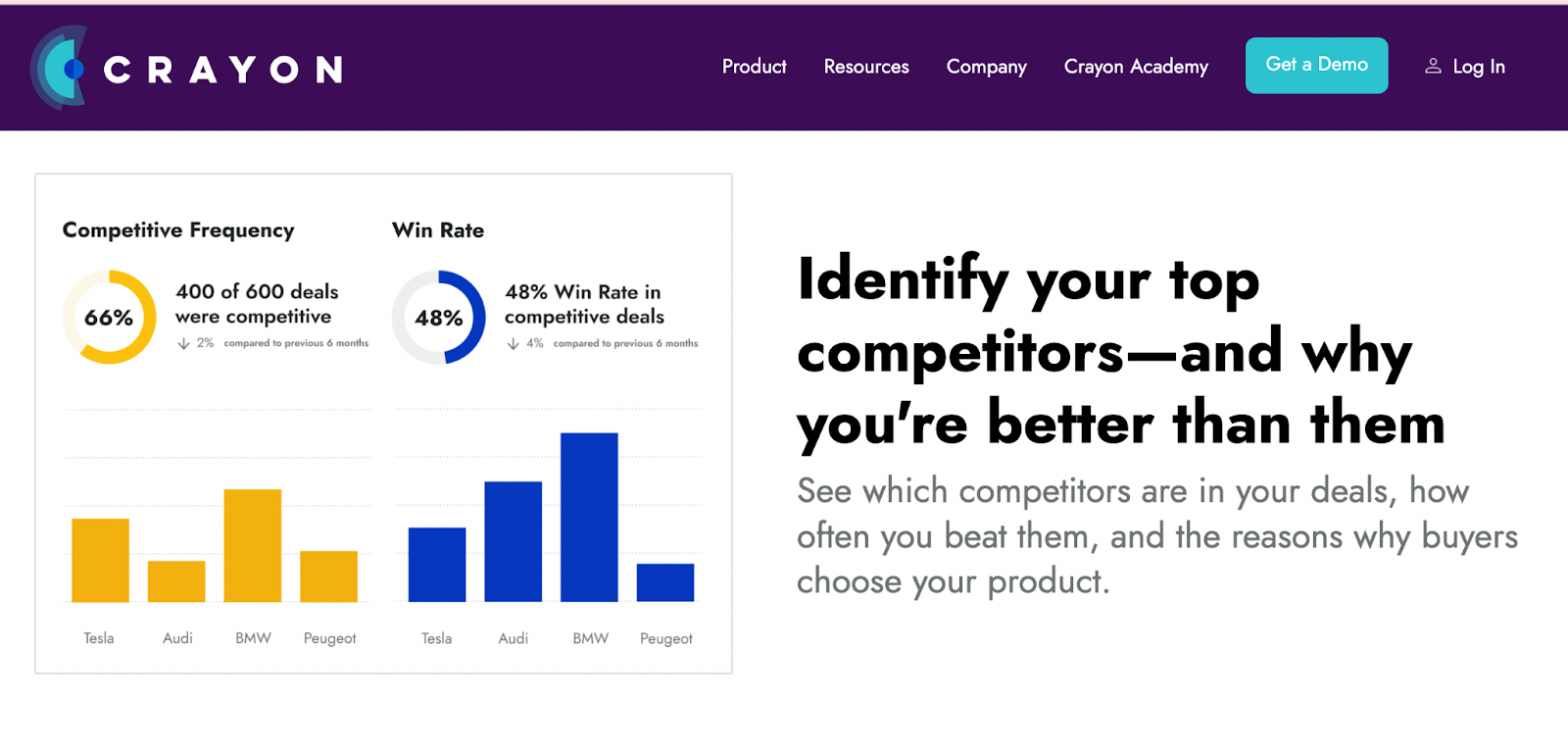
Crayon is a market intelligence platform that uses artificial intelligence (AI) to monitor and analyze competitors’ online presence across various channels, like websites, social media, and news articles.
The platform automates gathering all the data about your competitors and helps you find insights most relevant to your business using an AI-powered algorithm.
With Crayon, you can expand your competitive intelligence and make data-driven decisions.
Feedly
Feedly is a content aggregator that lets you monitor industry news and competitors’ content.
With Feedly, you can keep up to **** with your niche’s latest trends and strategies.
For a free alternative, consider using Google Alerts, which sends email notifications when new content related to your specified keywords appears online.
Prisync
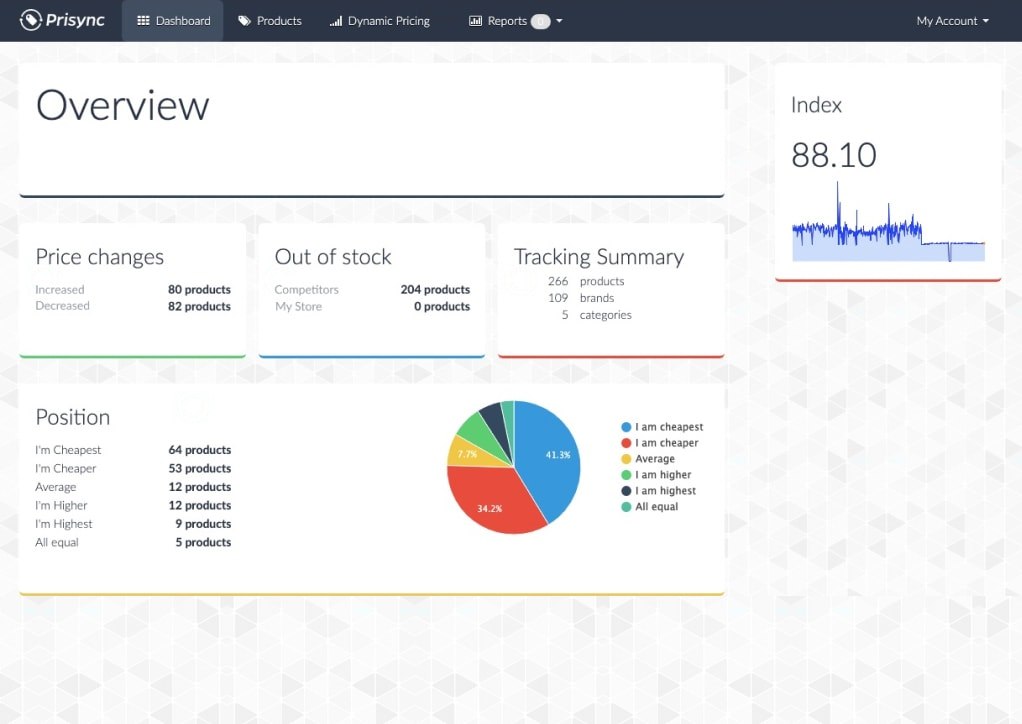
Prisync is an AI-driven price tracking and dynamic pricing software.
Prisync helps businesses optimize their pricing strategies and stay competitive by monitoring competitors’ prices, stock availability, and promotions.
It can also automate the repricing process to save time and resources.
Owletter
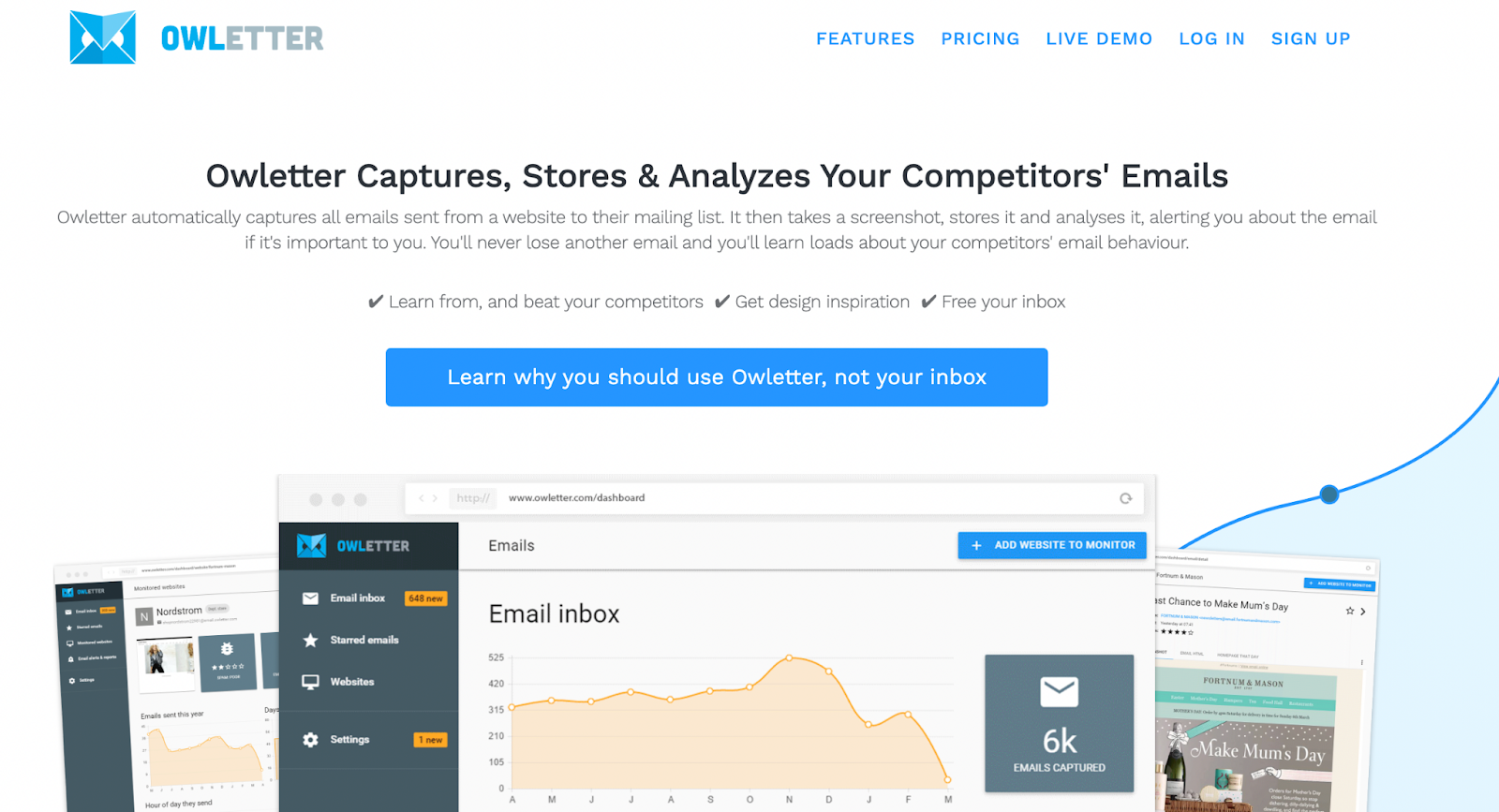
Owletter is a tool designed to analyze competitors’ email marketing strategies.
It captures and stores your competitors’ email campaigns, allowing you to review their content, frequency, and engagement metrics.
This information can help you identify successful strategies and potential improvement areas in your email marketing efforts.
Use Competitive Audits to Drive Your Business Forward
Competitive audits can fill the gaps in your current marketing strategy.
Define actionable goals for your audits. Focus on conducting audits that expand your view of the competitive landscape without collecting pointless data.
You can then get specific about the next steps based on your findings and use tools to automate the process.
The best place to start your next competitive audit?
Check out Semrush’s comprehensive Competitor Analysis tools.
Uncover every aspect of your competitors’ online presence with high-quality data at each stage of the journey. Start your free trial today.
Source link : Semrush.com
